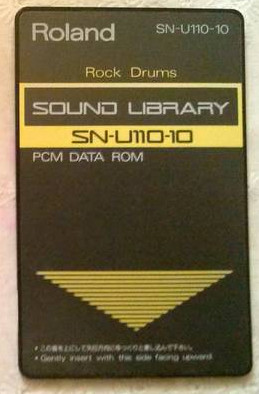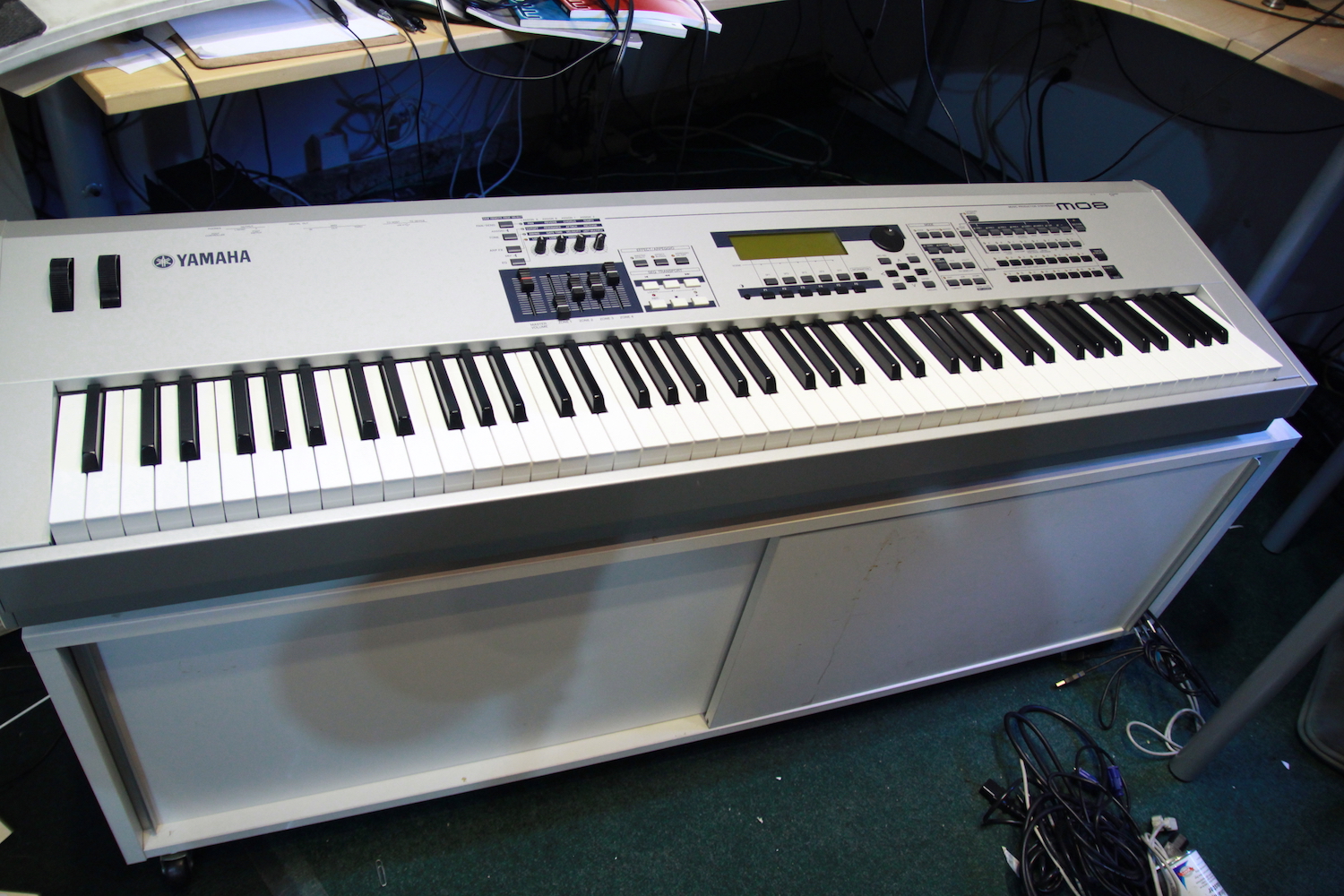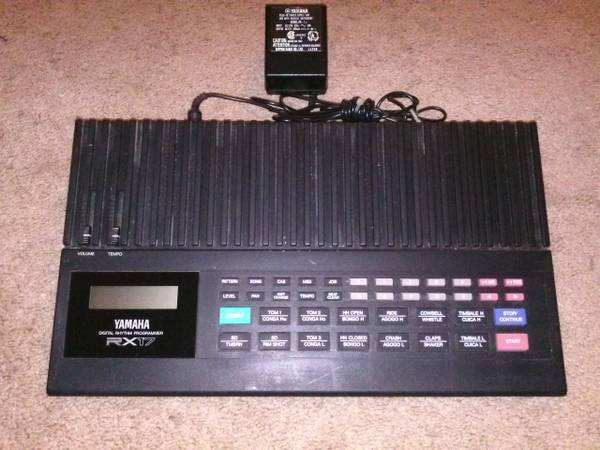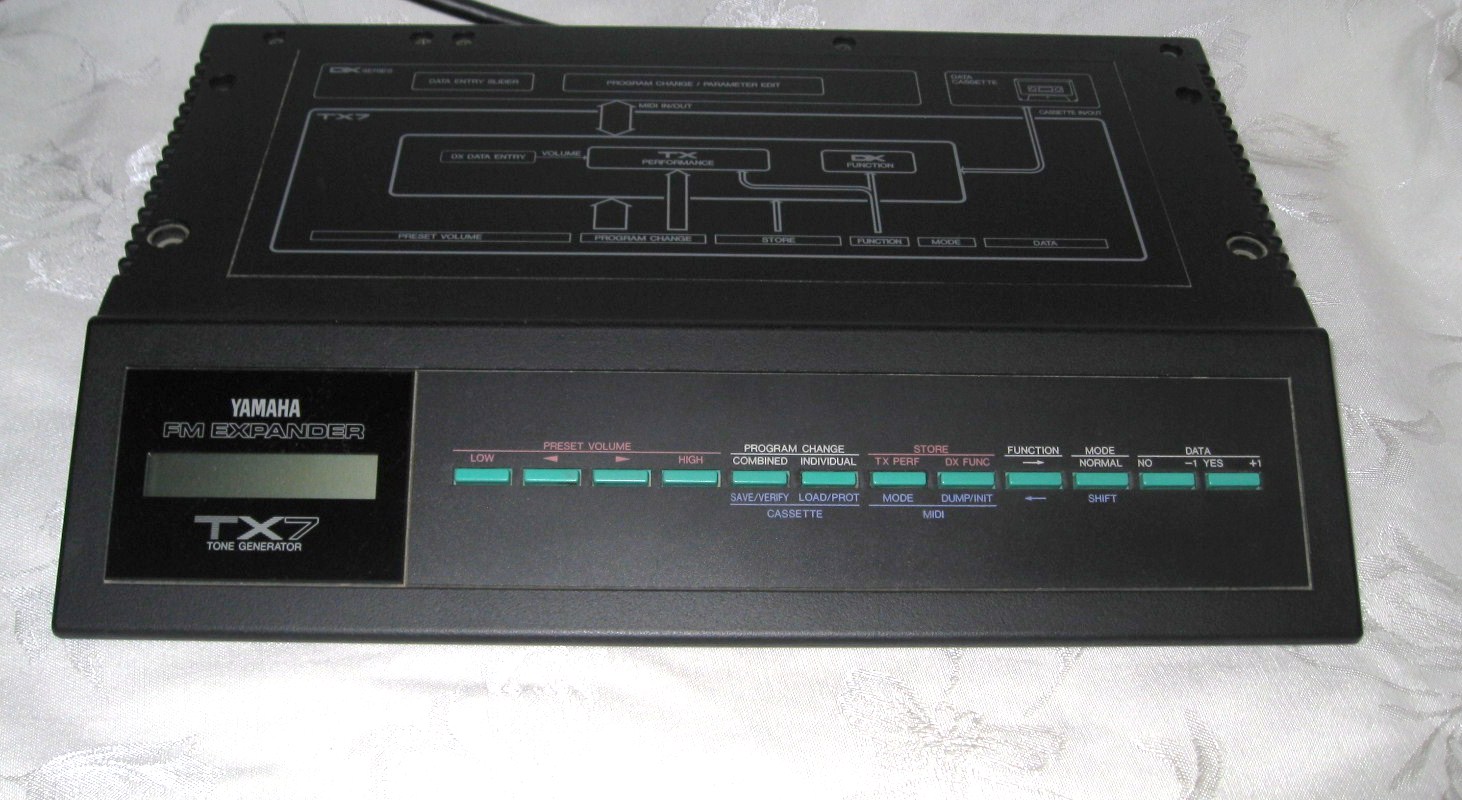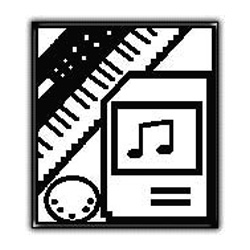Manufacturers
Categories
- Audio Recording Hardware - (306)
- Bargain Basement - (91)
- Computers - (5)
- DJ Hardware and Software - (20)
- EMB Book Shop - (187)
- Guitar - (89)
- Live Sound - (88)
- MIDI Hardware - (73)
- Music Software - (1140)
- Support/Lessons - (6)
- Used Gear - (139)
- -Audio MIDI Hardware Used - (13)
- -Basses - (1)
- -Computers - (10)
- -DJ Hardware
- -Guitars - (10)
- -Keyboard Ram & Roms Used - (10)
- -Keyboards and Modules - (33)
- -Pro Audio - (58)
- -Studio Rack & Furniture - (4)
- Video Creation Hardware Software - (8)
Specials [more]

Rare New Roland S770 L-709 Percussion Library Open Box
Save: 70% off
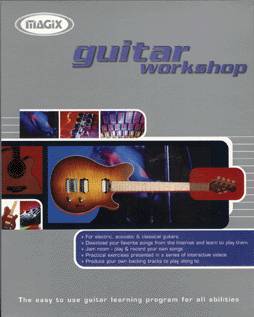
Magix GuitarWorkshop Windows Guitar Teaching Software
Save: 67% off
New Products [more]

Mackie 1402VLZ4 Used Mixer
East West Iconic Mac PC Instrument eLicense
Save: 33% off
Roland SH-32 Desktop Synthesizer Used
SH-32: Synthesizer is from the original owner who used it only his smoke free studio. It's in excellent condition. Includes the manual.
Features
- Powerful desktop synthesizer with massive realtime control
- New Wave Acceleration Synthesis creates a variety of synth waves-67 total
- Includes standard synth waves plus new waveforms like Spectrum and Noise
- Up to 32-note/4-part multitimbral operation
- 2 main oscillators and 2 suboscillators with ultra-thick Subsonic mode
- Pulse width modulation and oscillator "hard" sync capability
- insert and loop effects processors with 10 types of reverb/delay and 35 multi-effects
- Programmable arpeggiator for creating synth lines or drum patterns
- Patches using oscillator sync will be monophonic
The SH-32 uses new Wave Acceleration Synthesis to overcome the limited polyphony and sounds of modeling-based synths. You get up to 32 voices, plus 67 waveform variations from traditional analog waves to entirely new waveforms like Spectrum and variable Noise. And when combined with the new Subsonic mode found in the suboscillator section, you can create everything from thick bass sounds to entirely new sounds not possible on traditional synthesizers. There’s even drum maps with samples taken from the TR-808/909 Rhythm Composers.
Easy Knob and Slider Control
If you prefer creating sounds to using factory presets, you’ll love the SH-32. Like Roland’s instruments of the past, this tabletop synth is covered with all the knobs, sliders and buttons you need for direct parameter access. And because there are no hidden menus, the SH-32’s display consists of a simple, 3-digit LED.
Programmable Arpeggiator
The SH-32’s arpeggiator offers a variety of Preset templates, but can also be fully programmed. When used in combination with the Chord Memory function, you can produce complex arpeggios just like the ones heard in modern techno styles including trance. And with so many front-panel controls, programming is still ultra-intuitive.
Effects Processing
Once you’ve created a sound, you can process it though the SH-32’s two independent effects processors. The Loop processor gives you 10 varieties of reverb/delay effects, while the Insert processor offers 35 multi-effects algorithms. These include everything from distortion, compressor and pitch shifter to proprietary Groove effects like Slicer, Lo-Fi and Isolator.
An All-Purpose Performer
With its affordable price and compact size, the SH-32 is a great way to add fat synth sounds to your music. Use it with your favorite sequencing software or keyboard workstation, giving you bold new sounds. And when paired up with a Groovebox®, you’ve got a powerful desktop synth with cool, retro-style sequencing. So whether for live use or in the studio, the SH-32 will deliver the goods.
Specs
Sound Generator
- 2 x Oscillators (with Sub Oscillator, PWM, Oscillator Sync, or Ring Modulation), 1 x Filter (LPF/BPF/HPF/PKG/OFF), 1 x Amp, 2 x LFO (7 forms)
Note
- Patches using Oscillator Sync will be monophonic. These patches can be used in Part 1. Sub Oscillator, PWM, Oscillator Sync, and Ring Modulation cannot be used together in the same patch.
Parts
- 4 (or 3 + 1 Rhythm)
Maximum Polyphony
- 32 voices
Waveform
- 67 waves (7 categories) for main oscillators, 63 rhythm waves for rhythm sets
User Memory
- Patches: 128, Rhythm Sets: 2, Performances: 64
Preset Memory
- Patches: 128, Rhythm Sets: 2
Arpeggiator
- Style Programmable (Step Input/Realtime Input), Arpeggio Styles: 64, Rhythm Styles:64, Tempo = 20.0—250.0 BPM
Chord Memory
- Chord forms: 64
Display
- 8 segments, 3 characters (LED)
Connectors
- Output Jacks (L/MONO, R), MIDI Connectors (IN, OUT), Foot Switch Jack, Headphones Jack (Stereo), AC Adaptor Jack
Power Supply
- AC Adaptor (ACI Series/PSB-1U)
Current Draw
- 1,000 mA
Accessories
- AC Adaptor (ACI Series/ PSB-1U)
Size and Weight
Width
- 303 mm
- 11-15/16 inches
Depth
- 228 mm
- 9 inches
Height
- 92 mm
- 3-5/8 inches
Weight
- 1.9 kg
- 4 lbs. 4 oz.
Roland SN-U110-10 PCM Data Rom for the Roland U-110 Used
This is an used Roland SN-U110-10 PCM Data Rom for the Roland U-110 Synth and compatibles such the U-220, CM64, JV-1080 and others.
The SN-U110 Series offers high-quality waveform data created through Roland's RS-PCM technology.
SN-U110-10 Rock Drums
A very good selection of mainly rock, but also pop and electronic drum samples. There are the obligatory "Phil Collins" style gated snares and the mega-powerful '80s power toms, but also plenty of TR-808 sounds, Simmons electric drums, and some sampled oddities thrown in for good measure. Great card that expands the drum base of any synthesizer supporting the SN-U110-series of cards.
Roland U-220 w/ manual & Alexander's U220 tutorial manual. USED
Roland U-220 with manual and Alexander's U220 tutorial manual.
And here's one of the classic early ROMplers, the Roland U-220. It comes with both the original manual and Alexander's Easy to understand manual!
The U-220 is the successor to the original Roland U-110, and it's the rack version of the U-20 synthesizer. Both instruments came out right after the world-famous Korg M1 had raised the bar quite a bit for sample-based synthesizers, and, like the E-mu Proteus/1 (that came out at around the same time), were meant to provide the users with a solid base of "bread and butter" sounds for pop, rock and dance music.
The U-series uses a type of synthesis called RS-PCM - which stands for ReSynthesized Pulse Code Modulation, and it's Roland's 2nd generation sampling technique. It is based on high-quality samples.
The structure of this synth reminds of the D-50 and its tones, partials and patches. Here we have 128 basic components called "tones", that can be used to build "timbres". Timbres can then be combined in various ways to build "patches". This is a fairly elaborate process which seems daunting at the beginning, but fairly easy once you are used to the way the U-220's OS works.
Besides instrument waveforms/tones, the U-220 also features drum samples. They are fairly punchy and typically with an 80s feel. You can certainly use these percussion tones to form patches - indeed, some of the more creative factory patches use drum sounds as starting points.
One drawback of the U-series is that there are no filters. The editing options are few and limited to choosing tone, setting level, pitch, vibrato, and effects parameters.
This is definitely a plug 'n' play, performance synth: this module responds beautifully to velocity messages, and also the aftertouch is incredibly responsive and guarantees "felt" performances. It's also 6+1 (for rhythm) polytimbric, so you can use it to compose full songs.
The U-series can also be expanded thanks to two slots for the SN-U110-series of PCM cards, which really open up all kinds of possibilities for this machine.
$125.00Roland XV-5080 128-Voice Synth Module Used
This is a used Roland XV 5080 in excellent condition used in a smoke free studio.
Includes power cord. No Manual is included
The XV-5080 is Roland's ultimate sound module, based on the best-sounding, most expressive and expandable new synthesizer/sample player architecture in Roland history. This flagship module offers 128 voices, true stereo waveforms per Tone, expressive Matrix Control, expandability via new 64MB* SRX- and popular SR-JV80-Series wave expansion boards, Roland/Akai sample library compatibility and a host of new studio-quality effects.
Features:
- Roland's most powerful synthesizer/sample player in history
- 128 voices; 32-part multitimbral operation
- Over 1,200 factory patches
- Load up to 128MB of Roland, Akai, .WAV and AIFF samples
- 5 effects processors w/90 algorithms: 24-bit reverbs, COSM modeling, remix, RSS 3D effects, and more
- 8 24-bit analog outs w/ EQ; 2 S/PDIF outs; plus R-BUS 8-ch. digital out
- 4 SRX expansion slots and 4 SR-JV80 expansion slots
- New Matrix Modulation
- Built in SCSI and Wordclock Input
- SmartMedia patch and sample storage
Specs:
- Parts 32
- Max. Polyphony 128
- Memory 64MB (16-bit linear equivalent)
- Expansion Slot SR-JV80 Series: 4-slot, SRX Series: 4-slot, SIMM (72pin FP/EDO 64/32/16MB SIMM, Max. 128MB): 2-slot
- Preset Memory Patches: 1,152 (896 + 256 GM2 Patches)
- Performances: 64 (32 x 2 bank), Rhythm Sets: 23 (14 + 9 GM2 Rhythm Sets
- User Memory Patches: 128, Performances: 64, Rhythm Sets:
- External Storage: Device SmartMedia Card (2—128MB, 5/3.3 V): 1-slot
- Effects: Multi Effects: 90 types (3 different MFX can be used simultaneously in Performance Mode), Reverb: 4 types, Chorus: 2 types, System EQ (2 Band) per output
- Display: 320 x 80-dot Graphic Backlit LCD
- Connectors
- A (MIX) Output (L/Mono, R), B, C, D (Output (L, R)), or Individual Output 1 to 8,
- R-BUS (Only for output)
- Digital Audio Output (S/PDIF 44.1/48kHz (COAXIAL 1, OPTICAL 1))
- Word Clock In (BNC)
- SCSI (D-SUB 25-pin)
- Headphones
- MIDI (In 1/2, Out, Thru (In1))
- AC Inlet
- Power Consumption 25W (AC 117/230/240 V)
- Accessory: Sound List
- Options
- Wave Expansion Board (SRX Series, SR-JV80 Series),
- MIDI/SYNC cable (MSC-15/25/50)
Yamaha MO 8 88 Key Workstation Used
Yamaha MO 8 88 key Workstation Used
In good to excellent condition, used in a smoke free home studio. Here's more about it:
MOTIF synth power and DAW software control in an affordable, compact workstation.
The MO8 delivers Yamaha's powerful MOTIF synth engine functions and sounds in a compact, affordable workstation. Plus, it doubles as a powerful computer recording partner, giving you sounds and controls to use with your DAW software. The Yamaha keyboard has 88 hammer-action, touch-sensitive keys, 64-note polyphony, 256 user presets, 256 performance presets, 5-band master EQ, a backlit graphic LCD, plus USB and S/PDIF outs for digital connectivity.
FEATURES
88 key, balanced hammer-action, touch-sensitive board
DAW Remote Control supporting Mackie and Logic protocols
Studio Connections compatible
USB port
Tone Generator AWM2
64-note polyphony
16 internal multitimbral parts
175MB wave memory
1,859 waveforms
512 voices
64 drum kits
128 GM voices
1 GM drum kit
User: 128 x 2 banks + 32 drum kits
User performances: 256 (up to 4 parts)
18 filter types
20 reverbs
49 chorus effects
116 insert effects x 3 blocks
8 mastering effects
5-band master EQ
3-band stereo EQ
Note capacity: 226,000
Note resolution: 480 ppq (parts per quarter note)
Realtime recording
5 scenes per song
Pitch bend wheel
Modulation wheel
4 assignable control sliders
4 assignable knobs
Data dial performances
Dedicated front panel switch and store display pages
Stereo coaxial digital output
MIDI I/O
Yamaha RX17 Drum Machine Used
Yamaha RX17 Drum Machine from the 80s with the power supply
Features
13 Instrument Keys
Each Instrument Key can be instantly switched between two voices for a total of 26 recorded drum sounds. Level Adjustment
The level of each voice can be altered to balance the "drum kit" to precise specifications. Rhythm Tempo
Rhythm Patterns can be played back repeatedly, at any desired tempo from 40 to 250 quarter-notes a minute. Rhythm Pattern Creation
Up to 100 custom Rhythm Patterns can be generated by editing the preset Rhythm Patterns or creating new rhythms. The Patterns can be recorded in Real Time Write (play the instrument keys while listening to the Click Guide) or without automatic correction of timing. The Patterns can also be recorded in Step Write (entering one note at a time) to create perfectly timed Patterns. Following a Patterns recording, the Accent Edit mode will alter the level of each note, to add more realism.
Song Mode
Allows the combination of up to 999 Patterns in a single song, including intros, fills, repeats, tempo and volume changes. Up to 10 songs may be composed on the RX17, and Insert, Delete and Copy functions make song editing simpler.
Search Function
The Search Function locates any part of a song and allows the addition of new parts, similar to punching in on a tape recording.
MIDI Compatibility
The RX17 is a MIDI Instrument, and can control or be controlled by other MIDI equipment such as sequencers, synthesizers, and tone generators. It can be a part of a fully automated digital music system, or can provide the synchronization signal which keeps the performance together.
Cassette Storage
Once all Patterns and Songs have been programmed into memory, they can be saved on a standard cassette tape. They are stored in digital data form and can be loaded back into the RX17 at any time, allowing for the creation of a library of custom rhythms.
Specifications
Sound Source PCM, 2 Mbyte ROM
Number of Voices 26
Patterns 100
Songs 10 (Up to 999 Parts)
Keys Pattern, Song, Cas, MIDI, Job, Level, Pan, Instrument Change, Tempo, Beat Clear, 10 Numeric Keys (0-9), Stop-Continue, Start, Accent, Instrument Keys (13 Dual-Function)
Sliders Volume, Temp
Display LCD: 16 Characters x 2 Rows
5-Pin Din MIDI In, MIDI Out
8-Pin Din Cassette In-Out
Stereo 1/4" Phone Jack Headphones
Mono 1/4" Phone Jack Audio Out Right, Left (Mono)
DC 12 V In Tip Positive
Dimensions 350(w) x 54.5(h) x 202(d) mm (13-3/4 x 2-1/8 x 8 inches)
Weight 1.4kg (3lbs 7oz)
Yamaha TX16W Sampler with Library and Extras USED
Yamaha TX16W Sampler with library and extras
This sampler is in great condition with Yamaha 's Version 2.0 OS and Typhoon OS Version 1, owner's manuel, video, Typhoon's owner's manual, and a 100 or so disk library. Library includes sounds from Sound Source Unlimited.
The Yamaha TX16W is a rack mount sampler sound module made by Yamaha.
The TX16W has 12-bit sound with up to 50 kHz mono, and 33 kHz stereo sampling. Its filter is digital, allowing 17 different types, with 1 per voice. On the rear along with a regular stereo output, there are 8 individual outputs. Samples are stored on 720k 3.5" floppy disks. It shipped with 1.5MB of RAM but is expandable up to 6MB. The TX16W uses a Motorola 68000 processor.
The operating system is loaded from disk. Unsatisfied with the original Yamaha operating system, NuEdge Development created the Typhoon 1000 & 2000 OS for the TX16W, offering a different user interface, faster load time, less RAM usage, and more features, such as new filters.
Artists who use (or have used) the TX16W include:
Tarantula Hawk (2nd Album)
ThouShaltNot
Face Control
b'Hai Death
madtheory
Two Foot Tall Jerk
Yamaha TX7 FM Digital Synth Module Used
Used in a smoke free composer's studio. In excellent condition.
The TX7 is essentially a non-rack-mountable desktop module form of Yamaha'sDX7 FM synthesizer. Editing can not be done from the front panel, but must be accomplished externally via MIDI using either a DX7 keyboard, the PR-7 programmer or a computer. Software such as SoundQuest's MIDIQuest can be used to edit the parameters of the TX7. There are only 32 patches for storing any sounds as on the DX7. It's probably better to collect patches from the internet to expand your library of sounds since FM patch-editing is difficult enough on a professional DX synthesizer. Aside from its limitations, the TX7 is an affordable way to get your hands on original DX7 sounds. It has been used by Genesis, Human League and the producers behind the Spice Girls.
Tone generation in the TX7 is based on linear frequency modulation synthesis (FM), based on research by John Chowmning at Stanford University. The TX7 was known for precision and the flexibility of its bright, digital sounds, which were much clearer than those of the analog synthesizers that were available before it. The DX7 is well known for its electric piano, bells, and other "struck" and "plucked" sounds which emphasize complex attack transients. It is capable of 16-note polyphony. While the instrument is only capitible of playing one sound at a time it is notable how the sound of a single TX7 patch can change either subtly or wildly along the length of the keyboard or when played with different velocities. The TX7 features 32 algorithms, each being a different arrangement of its six sine wave operators, allowing for a great deal of programming flexibility.
Specifications
- Polyphony - 16 voices
- Oscillators - 6 FM operators and 32 algorithms
- #Instruments - (1) Monotimbral
- LFO - triangle / saw / square / sine / random
- VCA - 6 Envelope generators 8 parameters each
- Keyboard - none
- Memory - 32 patches
- Control - MIDI
- Date Produced - 1985
Yamaha TX81z Module Used
Used Yamaha TX81z In excellent condition. No manual but includes Sound Source Unlimited R&B DANCE Mac downloader 3.5 Floppy.
FM synthesizer from Yamaha, TX81z comes in a compact, multitimbral, 1-unit rackmount module.. The TX81Z was the first to employ a range of oscillator waveforms other than just sine waves giving it its unique, grating timbre. The TX81Z has better digital to analog converters many of its keyboard cousins, and has a reputation for producing more powerful bass sounds than similar vintage Yamaha synthesizers, such as the DX1. It's an inexpensive source of those sounds with lots of programmability. Eight voice polyphony, 128 preset sounds, 32 user and lots of functions hidden behind 11 push buttons.
he TX81Z features a new ability to use waveforms other than just a sine wave. There are eight voices that can be split, layered and detuned. Also onboard are pseudo-effects including delay and reverb. These features can be stored as performance setups. The effects are simply envelope and re-triggering effects. The TX81Z works great as a sound-module for any live or studio production. It's got a wider range of sounds than the DX-7, may not be quite as warm or 'classic' sounding, but at its low price and with the excellent MIDI implementation it makes a great alternative or backup synth for percussive, punchy FM synth sounds. It's used by Fluke, Roni Size, Astral Projection, Squarepusher, Jimmy Edgar, Future Sound of London, and Josh Wink.
The TX81Z is backwards-compatible with sound patches developed for Yamaha's DX21, DX27, DX100, and FB01 synthesizers
Specifications
- Polyphony - 8 notes
- Oscillators - 4-Operator Digital FM synthesizer
- #Instruments - 8 parts
- Filter - None
- Effects - Built-In Pseudo-Effects: Reverb by envelope modulation, Delay by re-triggering on free voices
- Keyboard - None
- Memory - 128 patches, 32 user, 24 performance setups
- Control - MIDI (w/ Velocity and Aftertouch)
- Date Produced - 1987
 The Electronic Music Box
The Electronic Music Box


